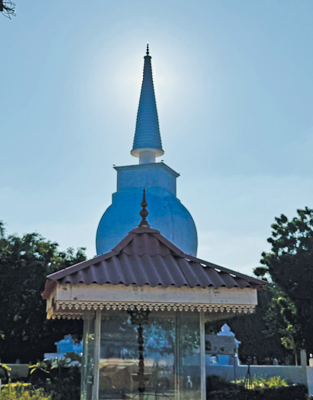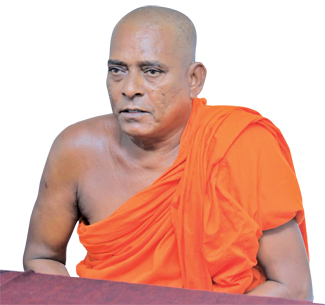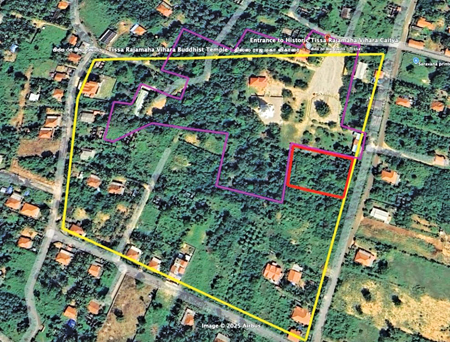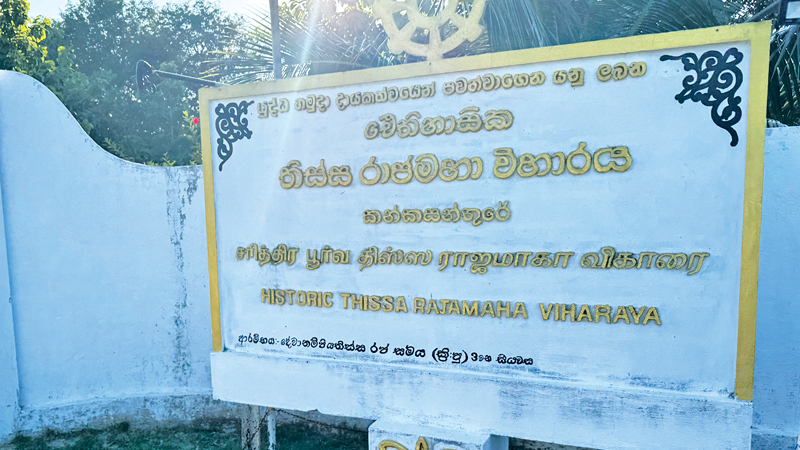Religious site or political battleground? How a land dispute and fake narratives are fueling ethnic divisions amid allegations and protests
“There are even false claims on social media that we intend to attack the temple. We will never resort to violence. We only seek justice. Many Sinhalese people who visited the temple have listened to our side of the story. We have video evidence of this”
****
 Kankesanthurai (KKS), on the northernmost tip of the Jaffna Peninsula holds immense geographical and historical significance. With its strategic coastal location, KKS has been a vital port and military base for centuries. The region, known for its ancient Hindu and Buddhist heritage, has witnessed the ebb and flow of history, from early Tamil settlements to colonial rule and the Sri Lankan civil war. Today, KKS remains a contested space where land ownership, religious sites and post-war resettlement spark tensions. Among the many disputed sites in the area, the Tissa Raja Maha Vihara in Thaiyiddy has become a focal point of controversy, with local villagers accusing the temple authorities of illegal land acquisitions. This article is an attempt to delve into the heart of the conflict, exploring the claims, counterclaims and historical narratives shaping the ongoing dispute.
Kankesanthurai (KKS), on the northernmost tip of the Jaffna Peninsula holds immense geographical and historical significance. With its strategic coastal location, KKS has been a vital port and military base for centuries. The region, known for its ancient Hindu and Buddhist heritage, has witnessed the ebb and flow of history, from early Tamil settlements to colonial rule and the Sri Lankan civil war. Today, KKS remains a contested space where land ownership, religious sites and post-war resettlement spark tensions. Among the many disputed sites in the area, the Tissa Raja Maha Vihara in Thaiyiddy has become a focal point of controversy, with local villagers accusing the temple authorities of illegal land acquisitions. This article is an attempt to delve into the heart of the conflict, exploring the claims, counterclaims and historical narratives shaping the ongoing dispute.
Contested site

Tissa Raja Maha Vihara
Located just 500 metres from the Kankesanthurai railway station, the Tissa Raja Maha Vihara has become the centre of an ongoing land conflict. During the Sunday Observer’s investigation, we stayed in a private guesthouse in Thaiyiddy, observing the activities around the temple. Our Reporter saw a significant presence of Buddhist devotees arriving from various parts of Sri Lanka.
To understand the villagers’ claims, we accompanied them to inspect the surrounding lands. They pointed out areas still under military control and others allegedly taken for the construction of the temple. According to them, the land belonging to the historic Tissa temple lies behind the newly built structure. They claim that a foundation stone for a temple was laid there many years ago but the temple was instead constructed elsewhere on their private lands.
Voice of landowners
According to Sukumari Sarujan from Thaiyiddy, her land which is now being occupied by the temple has long been in her family.
“These lands have been inherited from our ancestors. Our parents and ancestors shed their blood and sweat for these lands and we have an emotional connection to them. We cannot accept leaving these lands for alternative settlements. These lands were forcibly taken by the military and a temple was illegally built on them. If we accept this, it would set a dangerous precedent for future land grabs under the guise of religion.
She said that her struggle is not against a religion or a religious site. “It is about reclaiming our legally owned lands and removing an unauthorised structure built on the land”, she said.
Mangayarkarasi (69) is yet another affected landowner

Ven. Gintota Nandarama Thera
“The land near the Hindu Kovil belongs to me. It was inherited from my husband’s mother. The lands of 15 to 16 families in the area have been occupied and many affected families now live in rented houses without basic facilities,” she said.
According to her, one elderly woman who owns land here, travels from Chunnakam to protest for her rights, despite her age and frail health. She has no family to support her and this struggle is her only hope of reclaiming what is hers.
Meanwhile, another land owner claimed he found that his land was occupied on his family’s return after the end of the war.
“I purchased my land in 1982. We built a house, dug a well, took care of our parents and cultivated a garden. When we fled in 1990 due to the war, the land was still ours. But when we returned, we found it occupied by the military. We do not want compensation. We simply want our land back,” he said.
“The temple stands on 20 Parappu (about 1.25 acres) of land originally belonging to the Naga Vihara Thera. During the Good Governance Government, the then Northern Province Governor Reginald Cooray laid the foundation stone for a Buddhist temple there. However, the temple was not built at that location, and the land was abandoned,” a villager Sanujan said.
He said, however later, during the Covid-19 pandemic, when people were confined to their homes, the present temple was constructed on approximately 150 perches of private land. There is also a dispute between the Naga Vihara Thera and the bhikkhu at the Tissa temple. “You should ask the Naga Vihara Thera for the truth,” he said.
According to Sanujan, people in the South have misunderstood their struggle. “There are even false claims on social media that we intend to attack the temple. We will never resort to violence. We only seek justice. Many Sinhalese people who visited the temple have listened to our side of the story. We have video evidence of this,” he said.
Disputed history and archaeological claims

In red – land belonging to the people. Purple shows the land currently occupied by the temple, and in yellow- land planned for additional acquisition by the temple
Villagers denied the presence of any ancient Buddhist inscriptions or archaeological evidence on the site. They claimed that the Chief Incumbent of the Vihara has falsely asserted the existence of a 200-year-old inscription. They said that if such an inscription existed, it should be preserved by the Department of Archaeology, but they believe the claim to be misinformation. When asked why protests are held specifically on Poya days, the villagers explained.
“On Poya days, devotees from the South visit this temple. We use our protests to inform them about the truth. We do not resort to violence. Many Sinhalese visitors have listened to our grievances and acknowledged the legitimacy of our claims,”
They also claimed that no Buddhist families have ever lived in this area in recent history, except for a few temporary renters from the cement factory.
The villagers also said that they live under constant surveillance and threats. They alleged that the military, CID and Government intelligence officials closely monitor them and have issued warnings against their protests.
“Why was a temple built in an area where no Buddhists have historically lived?” they queried.
Temple authorities
However, the Chief Incumbent of the Vihara, Ven. Gintota Nandarama Thera, responding to the allegations said the temple has been mentioned in historical and ancient texts such as the Mahavansa, Bodhivansa and Ancient Lanka.
“There is a 200-year-old inscription here. This site has historical significance and it appears on maps from 1956 and within the Kankesanthurai city limits in 1971,” he said.
 According to these maps, the original Tissa Vihara had more than 14 acres of land. Some of this land has since been settled by people but the temple currently retains eight acres,” he added.
According to these maps, the original Tissa Vihara had more than 14 acres of land. Some of this land has since been settled by people but the temple currently retains eight acres,” he added.
The Thera denied allegations made by villagers of land grabbing.
“The villagers and I share a good relationship. I have taught them Sinhala and provided food to those in need. Only a few people, backed by politicians are making baseless claims. Their documents and title Deeds are fraudulent. If they truly own the land, why haven’t they taken the case to Court?” he queried.
When asked why they had not pursued legal action, the villagers cited the case of Kurundur Malai, where a similar land dispute was taken to Court. They claimed that the judge eventually left the country due to political pressure.
They claim that setting up the Vihara is a coordinated effort by the military and the Government.
“How can we, a small group of 16-20 people, fight against the State? We do not have the financial resources to wage a legal battle. We hope the new Government will ensure justice for us,” they said.
The villagers also pointed out that the new temple obstructs access to a local Hindu Kovil. They said that the main road leading to the Kovil passes through private lands, making it difficult for worshippers to reach their temple.
“During festivals, we need access for processions, but the temple authorities refuse to cooperate. They have denied our requests to open the road,” they said.
Several Tamil landowners recently met with the Ministry of Buddhasasana, Religious and Cultural Affairs Professor Hiniduma Sunil Senevi to discuss their concerns.
Speaking to an international media outlet recently, the Minister said that while this issue does not fall directly under his ministry’s purview, he has assured the public that he is willing to act as a mediator to help resolve it.
“Since there is a temple here, it partly falls under the Ministry’s purview. I advised them to submit a written request outlining their concerns, assuring them that I would step in as a mediator. I suggested they bring the matter before the District Coordination Committee, after which I will consult relevant institutions such as the Pradeshiya Sabha and the Divisional Secretariat, obtain their recommendations and work towards a resolution,” he said.
Social media and rising tensions
However, as the issue has gained widespread attention, some persons with vested interests have been attempting to sow discord between Tamil and Sinhalese communities by promoting false narratives.
The issue escalated when a group of Bhikkhus and Buddhists from the South visited the village last week to inaugurate a newly constructed building at Tissa Vihara. Their visit was met with strong opposition from local villagers and landowners. Allegations were raised against the Government, claiming that soldiers who had been guarding the temple were removed. Following the circulation of videos and photos from the event on social media, the topic resurfaced, fuelling discussions online. Several social media posts and videos, including ones targeting the Tamil community were widely shared as a result.
The Chief Incumbent of the Nagadeepa Rajamaha Vihara Ven. Nawadagala Padumakitti Tissa Thera released a special statement on his official Facebook page last week regarding the Tissa Vihara dispute.
In his statement, the Thera called upon Sinhala Buddhists to remain calm and act carefully, emphasizing that the land belonging to the temple was officially allocated by the Divisional Secretariat after the war. However, he alleged that bhikkhus from outside had forcibly taken over lands belonging to Tamil people and secretly constructed the temple with the support of the military.
“The Tamil people never occupied the land belonging to the temple, but bhikkhus from elsewhere have forcibly taken over Tamil-owned land. This is the truth,” the Thera said.
He further called for unity and peaceful coexistence, urging people to visit the Tissa Vihara and speak to the residents to understand the real situation.
Pix By Shabeer Mohamed









